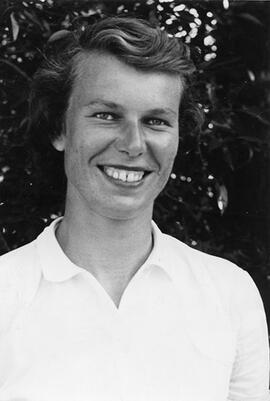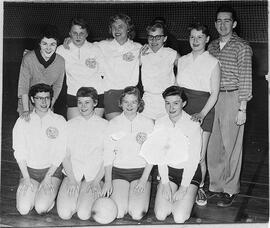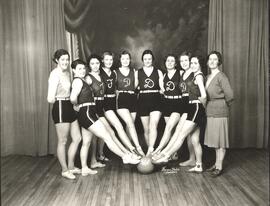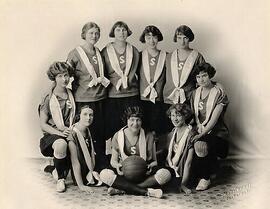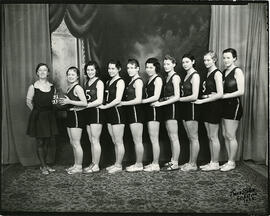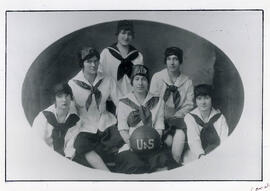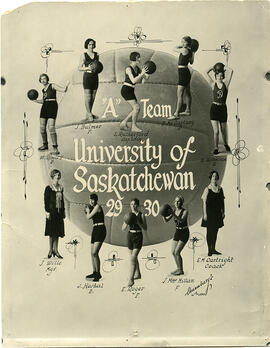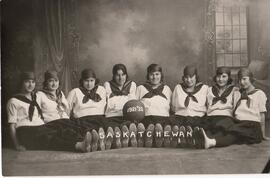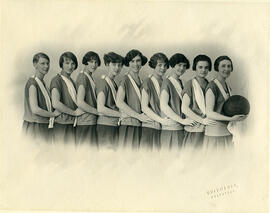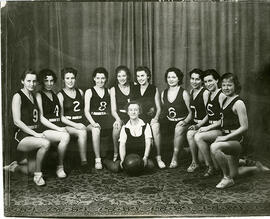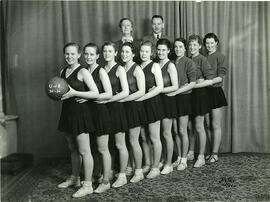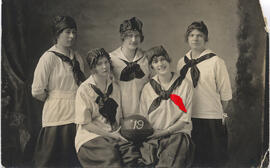- A-10486
- Item
- 1957
Head and shoulders image of Pat Lawson, instructor, School of Physical Education.
Bio/Historical Note: Dr. Patricia A. (Pat) Lawson was born on 18 November 1929 in Saskatoon and attended Caswell Elementary School. Lawson won every track and field event she entered while attending Bedford Road Collegiate. She won provincial titles in six different sports and five Canadian titles in three sports. She broke records for the 220- and 440-yard events in speed skating, and became Canadian intermediate ladies champion in 1947 and Canadian senior ladies champion in 1949 and 1954. While attending the 1947 Canadian track and field championships, she won gold in shot put, the first time she had competed in the event. Lawson won two Canadian basketball championships; one with the Vancouver Eilers in 1956 and one with the Saskatoon Adilman Aces in 1959. She was one of five Aces to represent Canada at the 1959 Pan Am Games in Chicago. Lawson had similar success as a golfer: she was a five-time winner of the Saskatchewan Senior Women's championship, Lawson represented the University of Saskatchewan on 13 teams over 4 years (basketball 4, swimming 4, tennis 3, track and field 2). She graduated with a BA (1950) and a BEd (1953). In 1956 Lawson joined the faculty of the College of Physical Education at the U of S, where she was a teacher, coach and administrator before being named women’s athletic director. She coached the Huskiettes basketball team from 1956-1964 and again in 1967-1968. In 1966 she was named coach of Canada’s national women’s basketball team. Lawson completed a Masters degree in physical education at the University of Oregon (1959) and a PhD at the University of Southern California (1967). Lawson retired from the U of S as Professor Emerita in 1990.
In 1984 Lawson became president of the Canadian Association for Health, Physical Education and Recreation (CAHPER). She was also president of the Canadian Women's Intercollegiate Athletic Union, which improved opportunities for women in intercollegiate athletics, and served a term as chairperson for the National Advisory Council on Fitness and Amateur Sport. Lawson was named a Fellow in the North American Society Health, Physical Education, Recreation, Sport and Dance. She was honoured with the Canadian Association for Health, Physical Education and Recreation (CAHPER) Honor Award. Lawson was a member of the Saskatoon Sports Hall of Fame for golf, basketball, and with the Adilman Aces basketball team that won the Canadian Championship and competed at the 1959 Pan‐American Games. The Saskatchewan Sports Hall of Fame inducted Lawson as a multi‐sport athlete to recognize her provincial championships in six different sports: swimming, track and field, tennis, basketball, speed skating and golf. The U of S has honoured her twice as a member of the Athletic Wall of Fame. Lawson was also recognized by the College of Kinesiology as one of the “First and Best” in 1996. She competed nationally as a member of Saskatchewan golf teams seven times in the Amateur Women’s and 12 times in the Senior Women’s. She was provincial Senior Champion five times, and runner‐up four times between 1980 and 1994. Lawson was the first woman elected to the Riverside Country Club Board of Directors. She won the Waskesiu Ladies’ Lobstick five times over four decades from 1968 to 1991. Lawson was also a member of the Bedford Road Collegiate Hall of Honour and the Saskatchewan Golf Hall of Fame; Additional recognition included being recipient of the College of Arts and Science "Alumni of Influence Award"; and the U of S Alumni Achievement Award in 2018. Lawson died of lung cancer in Saskatoon on 10 October 2019 at age 90. She was survived by partner Barbara Dorsey, former professor of Physical Education at the U of S.

